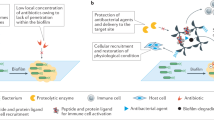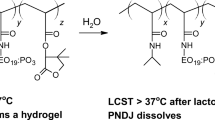Abstract
This work demonstrates a slow, sustained drug delivery system that provides on-demand delivery bursts through the application of pulsed therapeutic ultrasound (TUS). Insoluble β-cyclodextrin-polymer (pCD) disks were loaded with a saturated antibiotic solution of rifampicin (RIF) and used for drug delivery studies. To obtain on-demand release from the implants, TUS was applied at an intensity of 1.8 W/cm2. The therapeutic efficacy of the combination treatment was assessed in bacterial culture via an in vitro Staphylococcus aureus bioluminescence assay. The results demonstrated that the application of pulsed TUS at 3 MHz and 1.8 W/cm2 to pCD implants leads to a significantly higher short-term burst in the drug release rate compared to samples not treated with TUS. The addition of TUS increased the drug release by 100% within 4 days. The pCD disk + RIF stimulated with TUS showed a comparatively higher bacterial eradication with CFU/mL of 4.277E+09, and 8.00E+08 at 1 and 24 h compared with control treated bacteria at 1.48E+10. Overall, these results suggest that the addition of pulsed TUS could be an effective technology to noninvasively expedite antibiotic release on demand at desired intervals.







Similar content being viewed by others
References
Ahmed, M., C. L. Brace, F. T. Lee, Jr, and S. N. Goldberg. Principles of and advances in percutaneous ablation. Radiology 258(2):351–369, 2011.
Alneami, A., E. G. Khalil, R. Mohsien, and A. Albeldawi. A comparison of six ultrasound stimulation types on pseudomonas aeruginosa growth in vitro. J. Biomed. Phys. Eng. 8(2):203, 2018.
An, Y. H., and R. J. Friedman. Prevention of sepsis in total joint arthroplasty. J. Hosp. Infect. 33(2):93–108, 1996.
Arciola, C. R., L. Visai, F. Testoni, S. Arciola, D. Campoccia, P. Speziale, et al. Concise survey of Staphylococcus aureus virulence factors that promote adhesion and damage to peri-implant tissues. Int J Artif Org 34(9):771–780, 2011.
Bibby, D. C., N. M. Davies, and I. G. Tucker. Mechanisms by which cyclodextrins modify drug release from polymeric drug delivery systems. Int. J. Pharm. 197(1–2):1–11, 2000.
Busscher, H. J., and H. C. van der Mei. How do bacteria know they are on a surface and regulate their response to an adhering state? PLoS Pathog. 8(1):2012.
Campoccia, D., L. Montanaro, and C. R. Arciola. The significance of infection related to orthopedic devices and issues of antibiotic resistance. Biomaterials 27(11):2331–2339, 2006.
Corvec, S., M. E. Portillo, B. M. Pasticci, O. Borens, and A. Trampuz. Epidemiology and new developments in the diagnosis of prosthetic joint infection. Int. J. Artif. Org. 35(10):923–934, 2012.
Cyphert, E. L., S. T. Zuckerman, J. N. Korley, and H. A. von Recum. Affinity interactions drive post-implantation drug filling, even in the presence of bacterial biofilm. Acta Biomater. 57:95–102, 2017.
Del Pozo, J. L., and R. Patel. Infection associated with prosthetic joints. N. Engl. J. Med. 361(8):787–794, 2009.
Epstein-Barash, H., G. Orbey, B. E. Polat, R. H. Ewoldt, J. Feshitan, R. Langer, et al. A microcomposite hydrogel for repeated on-demand ultrasound-triggered drug delivery. Biomaterials 31(19):5208–5217, 2010.
Engelsman, A. F., H. C. van der Mei, R. J. Ploeg, and H. J. Busscher. The phenomenon of infection with abdominal wall reconstruction. Biomaterials 28(14):2314–2327, 2007.
Falagas, M. E., S. K. Kasiakou, and L. D. Saravolatz. Colistin: the revival of polymyxins for the management of multidrug-resistant gram-negative bacterial infections. Clin. Infect. Dis. 40(9):1333–1341, 2005.
Fu, A. S., T. R. Thatiparti, G. M. Saidel, and H. A. von Recum. Experimental studies and modeling of drug release from a tunable affinity-based drug delivery platform. Ann. Biomed. Eng. 39(9):2466–2475, 2011.
Gourevich, D., O. Dogadkin, A. Volovick, L. Wang, J. Gnaim, S. Cochran, et al. Ultrasound-mediated targeted drug delivery with a novel cyclodextrin-based drug carrier by mechanical and thermal mechanisms. J. Control. Release 170(3):316–324, 2013.
Haugse, R., A. Langer, S.-E. Gullaksen, S. M. Sundøy, B. T. Gjertsen, S. Kotopoulis, et al. Intracellular signaling in key pathways is induced by treatment with ultrasound and microbubbles in a leukemia cell line, but not in healthy peripheral blood mononuclear cells. Pharmaceutics 11(7):319, 2019.
Horsley, H., J. Owen, R. Browning, D. Carugo, J. Malone-Lee, E. Stride, et al. Ultrasound-activated microbubbles as a novel intracellular drug delivery system for urinary tract infection. J. Control. Release 301:166–175, 2019.
Huebsch, N., C. J. Kearney, X. Zhao, J. Kim, C. A. Cezar, Z. Suo, et al. Ultrasound-triggered disruption and self-healing of reversibly cross-linked hydrogels for drug delivery and enhanced chemotherapy. Proc. Natl. Acad. Sci. U.S.A. 111(27):9762–9767, 2014.
Humphreys, H. Surgical site infection, ultraclean ventilated operating theatres and prosthetic joint surgery: where now? J. Hosp. Infect. 81(2):71–72, 2012.
Jeganathan, S., E. Budziszewski, P. Bielecki, M. C. Kolios, and A. A. Exner. In situ forming implants exposed to ultrasound enhance therapeutic efficacy in subcutaneous murine tumors. J. Control. Release 324:146–155, 2020.
Juric, D., N. A. Rohner, and H. A. von Recum. Molecular imprinting of cyclodextrin supramolecular hydrogels improves drug loading and delivery. Macromol. Biosci. 19(1):1800246, 2019.
Kurtz, S. M., E. Lau, H. Watson, J. K. Schmier, and J. Parvizi. Economic burden of periprosthetic joint infection in the United States. J. Arthroplasty 27(8):61–65, 2012.
Kurtz, S., K. Ong, E. Lau, F. Mowat, and M. Halpern. Projections of primary and revision hip and knee arthroplasty in the United States from 2005 to 2030. JBJS 89(4):780–785, 2007.
Loftsson, T., S. B. Vogensen, M. E. Brewster, and F. Konrádsdóttir. Effects of cyclodextrins on drug delivery through biological membranes. J. Pharm. Sci. 96(10):2532–2546, 2007.
Montanaro, L., P. Speziale, D. Campoccia, S. Ravaioli, I. Cangini, G. Pietrocola, et al. Scenery of Staphylococcus implant infections in orthopedics. Future Microbiol. 6(11):1329–1349, 2011.
Montanaro, L., F. Testoni, A. Poggi, L. Visai, P. Speziale, and C. R. Arciola. Emerging pathogenetic mechanisms of the implant-related osteomyelitis by Staphylococcus aureus. Int. J. Artif. Org. 34(9):781–788, 2011.
Sesal, N. C., and Ö. Kekeç. Effects of pulsed ultrasound on Escherichia coli and Staphylococcus aureus. Trans. R. Soc. Trop. Med. Hyg. 108(6):348–353, 2014.
Singh, K., J. M. Bauer, G. Y. LaChaud, J. E. Bible, and H. R. Mir. Surgical site infection in high-energy peri-articular tibia fractures with intra-wound vancomycin powder: a retrospective pilot study. J. Orthopaedics Traumatol. 16(4):287–291, 2015.
Thatiparti, T. R., and H. A. von Recum. Cyclodextrin complexation for affinity-based antibiotic delivery. Macromol. Biosci. 10(1):82–90, 2010.
Uçkay, I., S. Harbarth, R. Peter, D. Lew, P. Hoffmeyer, and D. Pittet. Preventing surgical site infections. Expert Rev. Anti-infective Ther. 8(6):657–670, 2010.
Vertullo, C. J., M. Quick, A. Jones, and J. E. Grayson. A surgical technique using presoaked vancomycin hamstring grafts to decrease the risk of infection after anterior cruciate ligament reconstruction. Arthroscopy. 28(3):337–342, 2012.
Villatte, G., C. Massard, S. Descamps, Y. Sibaud, C. Forestier, and K.-O. Awitor. Photoactive TiO2 antibacterial coating on surgical external fixation pins for clinical application. Int. J. Nanomed. 10:3367, 2015.
Von Eiff, C., C. R. Arciola, L. Montanaro, K. Becker, and D. Campoccia. Emerging Staphylococcus species as new pathogens in implant infections. Int. J. Artif. Org. 29(4):360–367, 2006.
Wang, N. X., and H. A. von Recum. Affinity-based drug delivery. Macromol. Biosci. 11(3):321–332, 2011.
Xin, Z., G. Lin, H. Lei, T. F. Lue, and Y. Guo. Clinical applications of low-intensity pulsed ultrasound and its potential role in urology. Transl. Androl. Urol. 5(2):255–266, 2016.
Author information
Authors and Affiliations
Corresponding authors
Additional information
Associate Editor Stefan M Duma oversaw the review of this article.
Publisher's Note
Springer Nature remains neutral with regard to jurisdictional claims in published maps and institutional affiliations.
Rights and permissions
About this article
Cite this article
Bohara, S., Rohner, N., Budziszewski, E. et al. Ultrasound Triggered Drug Release from Affinity-Based β-Cyclodextrin Polymers for Infection Control. Ann Biomed Eng 49, 2513–2521 (2021). https://doi.org/10.1007/s10439-021-02814-y
Received:
Accepted:
Published:
Issue Date:
DOI: https://doi.org/10.1007/s10439-021-02814-y




